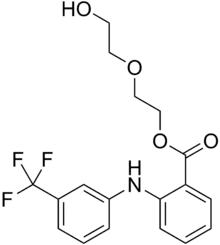 | |
| Clinical data | |
|---|---|
| AHFS/Drugs.com | International Drug Names |
| Routes of administration | Topical (cream, gel, spray) |
| ATC code | |
| Legal status | |
| Legal status |
|
| Pharmacokinetic data | |
| Protein binding | 98–99% |
| Metabolites | Flufenamic acid, hydroxyl derivatives |
| Excretion | 35% renal, mostly biliary |
| Identifiers | |
| |
| CAS Number | |
| PubChem CID | |
| DrugBank | |
| ChemSpider | |
| UNII | |
| KEGG | |
| CompTox Dashboard (EPA) | |
| ECHA InfoCard | 100.045.650 |
| Chemical and physical data | |
| Formula | C18H18F3NO4 |
| Molar mass | 369.340 g·mol−1 |
| 3D model (JSmol) | |
| |
| |
| (verify) | |
Etofenamate is a nonsteroidal anti-inflammatory drug (NSAID) used for the treatment of joint and muscular pain.[1] It is available for topical application as a cream, a gel or as a spray.
Etofenamate is acutely toxic if swallowed; it is also very toxic to aquatic life, with long lasting effects.[2]
References
This article is issued from Wikipedia. The text is licensed under Creative Commons - Attribution - Sharealike. Additional terms may apply for the media files.